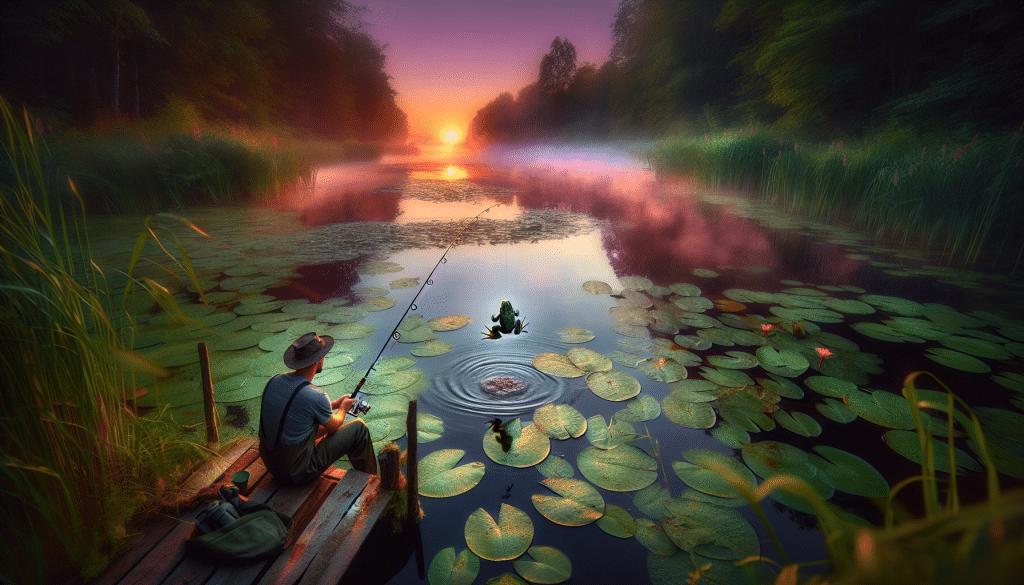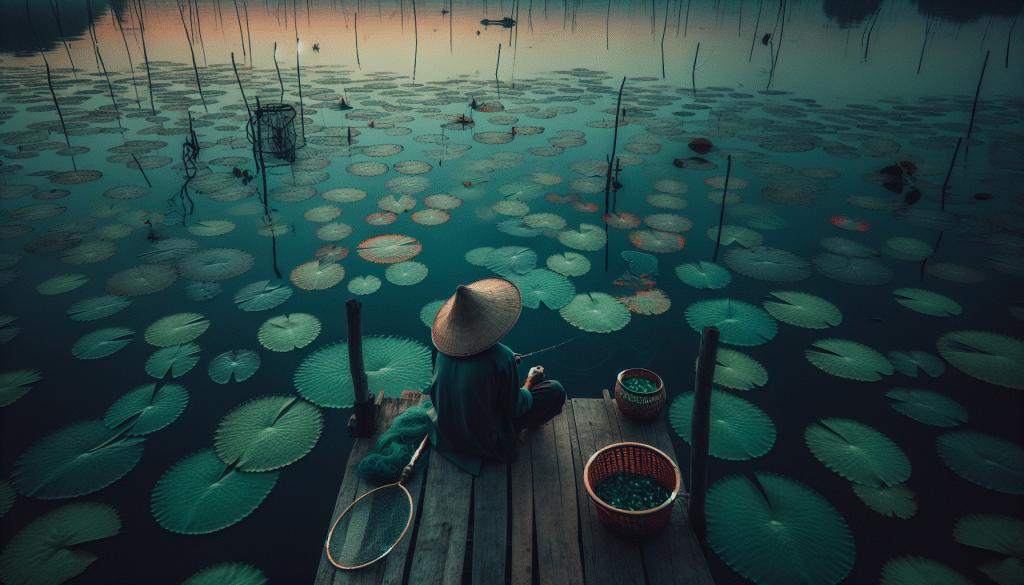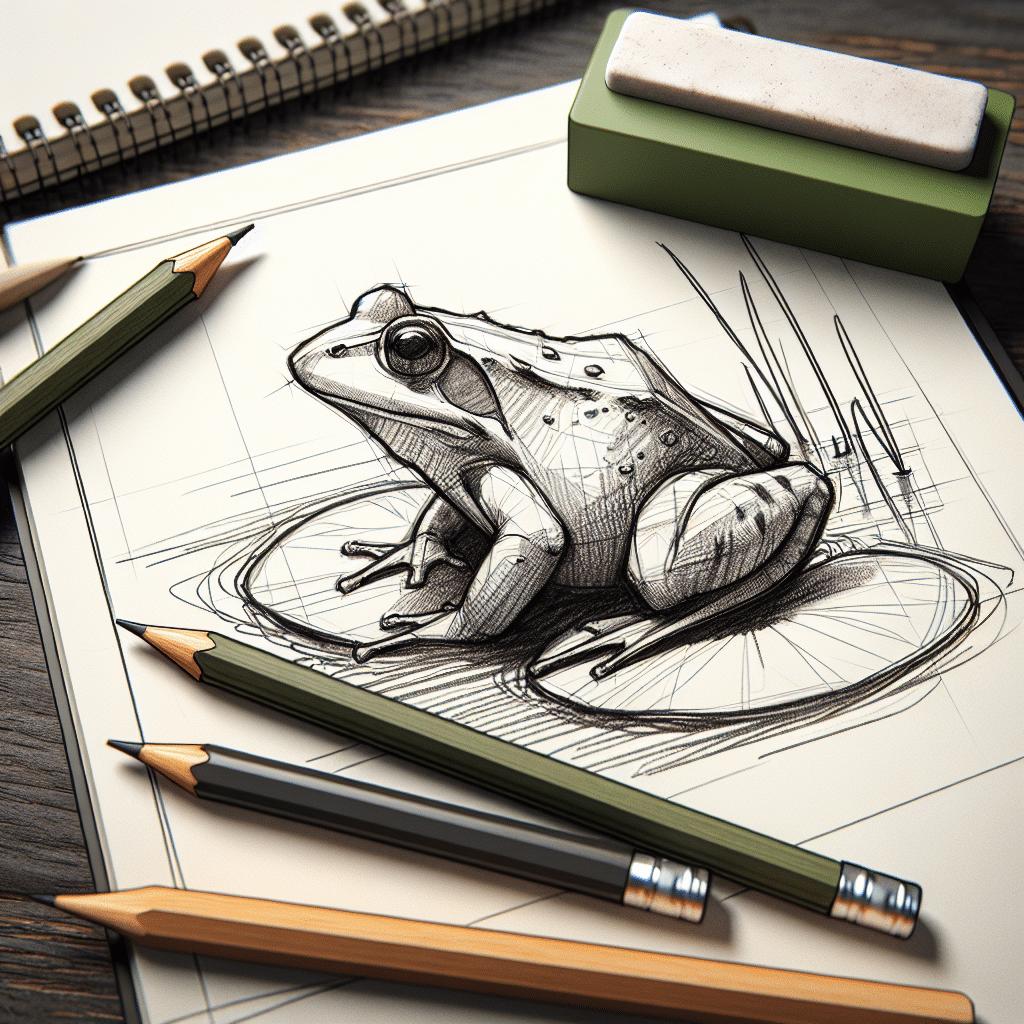So, you’ve decided to take up the unconventional hobby of frog fishing, huh? Well, you’re in for an exciting and unique experience! In this beginner’s guide, we’ll show you the ins and outs of frog fishing, from selecting the right equipment to mastering the art of luring those slippery amphibians. Whether you’re angling for a fun day out on the water or looking to add some excitement to your fishing repertoire, this article has got you covered. Get ready to dive into the fascinating world of frog fishing!

Understanding Frogs and Their Habitats
Frogs are fascinating creatures that are found in various habitats all around the world. These amphibians have some unique characteristics that set them apart from other animals. They have smooth and moist skin, which allows them to breathe through their skin. They also have powerful hind legs, which enable them to jump long distances. Additionally, frogs lay eggs in water and undergo metamorphosis from tadpoles to adult frogs. Understanding these basic characteristics of frogs is essential when it comes to fishing for them.
There are several different types of frogs, each with its own unique characteristics and habitats. Some common types include bullfrogs, leopard frogs, and tree frogs. Bullfrogs prefer large bodies of water, such as lakes and ponds, with plenty of vegetation for cover. Leopard frogs, on the other hand, can be found in both aquatic and terrestrial habitats, such as swamps and meadows. Tree frogs, as the name suggests, live in trees and are adept at climbing and clinging to branches. Knowing the specific habitats of different frog species is crucial when planning a frog fishing trip.
Frogs have specific adaptations that allow them to thrive in aquatic environments. These adaptations play a significant role in their ability to catch prey and evade predators. For instance, frogs have webbed feet, which help them swim efficiently. They also have long tongues and sticky pads on their feet, which aid in catching insects and other small organisms. Additionally, frogs have a unique system called a “lateral line” that allows them to detect vibrations in the water and pinpoint the location of their prey. Understanding these adaptations can help anglers choose the right techniques and lures for frog fishing.
Equipment Needed for Frog Fishing
When it comes to frog fishing, having the right equipment is essential for a successful and enjoyable experience. The following are some of the types of rods and reels suitable for frog fishing:
-
Heavy or Medium-Heavy Casting Rods: Frog fishing requires a rod with enough backbone to handle the weight and power of these amphibians. A heavy or medium-heavy casting rod is ideal for this purpose, as it provides enough strength and sensitivity to handle the fight of a hooked frog.
-
Baitcasting Reels: Baitcasting reels are commonly used for frog fishing, as they offer better control and accuracy when casting heavy lures. These reels also have a higher gear ratio, which allows for a faster retrieval speed, vital when setting the hook on a frog.
The fishing line is another crucial component of frog fishing equipment. The ideal fishing line types and weights for frog fishing are:
-
Braided Fishing Line: Braided fishing lines are commonly used for frog fishing due to their high strength and low stretch. A braided line with a pound test ranging from 30 to 50 is recommended for frog fishing, as it can withstand the weight and power of a hooked frog.
-
Fluorocarbon Fishing Line: Fluorocarbon fishing lines are also suitable for frog fishing, as they are nearly invisible in water and offer excellent sensitivity. A fluorocarbon line with a pound test ranging from 10 to 20 can be used as a leader when using braided mainline.
When it comes to lures, there are various options available for frog fishing. Some popular and effective lures include:
-
Hollow Body Frogs: Hollow body frogs are one of the most common and effective lures for frog fishing. These lures mimic the appearance and movement of a live frog, making them irresistible to predatory fish. They have a hollow body that collapses upon a fish striking, exposing the hooks for a better hookset.
-
Soft Plastic Frogs: Soft plastic frogs are another popular choice for frog fishing. These lures are made of soft and flexible materials that give them a lifelike appearance and movement in the water. They often come with weedless hooks, allowing anglers to fish them in dense vegetation without getting snagged.
Carrying a net is essential when fishing for frogs. When you successfully hook a frog, using a net to scoop it out of the water is much safer and kinder than trying to land it with your hands. Additionally, a net allows you to handle the caught frog more easily and reduces the risk of injury to both you and the frog.

Preparing for a Frog Fishing Trip
Before heading out for a frog fishing trip, there are several factors to consider to ensure a successful outing.
First and foremost, it is important to decide on the appropriate time for frog fishing. Frogs are most active during the warmer months, especially at night when they come out to feed and mate. Therefore, planning your frog fishing trip during spring and summer, when temperatures are generally higher, is ideal.
Choosing the right location is also crucial for a successful frog fishing trip. Look for bodies of water known to have a healthy frog population, such as ponds, lakes, and marshes. These habitats offer the necessary food sources and breeding grounds, making them ideal for frogs.
Weather conditions play a significant role in the success of a frog fishing trip. Frogs are more active in warm and humid weather, so planning your fishing trip on a day with these conditions increases your chances of catching frogs. Pay attention to weather forecasts and plan accordingly.
When going frog fishing, it is essential to wear appropriate clothing. Consider wearing lightweight, breathable clothing that provides protection from insects and the elements. Long pants, long sleeves, and a hat are recommended to protect yourself from mosquitoes and sun exposure. Additionally, wearing proper footwear, such as waterproof boots or waders, can help you navigate through wet and muddy areas.
Techniques and Strategies for Frog Fishing
Mastering the techniques and strategies for frog fishing is key to hooking and landing these elusive amphibians. Here are some techniques and strategies to consider:
Different casting methods can be used when frog fishing, depending on the habitat and the desired presentation. One popular technique is the “walk the frog” technique. To perform this technique, cast your frog lure near a lily pad or any other vegetation, and then twitch the rod tip to make the frog “walk” across the water’s surface. This mimics the natural movement of a frog, attracting predatory fish.
Retrieving techniques for frog lures can vary depending on the situation. One effective technique is the “pop and stop” method. After casting your frog lure near a potential frog hiding spot, give it a series of short and quick pops to create commotion on the water’s surface. Then pause for a few seconds to imitate a resting frog. This action often triggers predatory fish to strike.
Attracting frogs is another strategy to consider when frog fishing. Using a combination of frog calls and vibrations in the water, you can create a natural and enticing environment for frogs. Mimicking the sound of a frog’s mating call or the sound of a struggling frog can trigger a response from nearby frogs and attract them to your fishing area.

Handling Caught Frogs
Knowing how to handle caught frogs safely is essential for their well-being and your own safety. When handling a caught frog:
-
Wet your hands before touching the frog. Frogs have very sensitive skin, and dry hands can cause damage or remove the protective slime coating on their skin.
-
Gently hold the frog with both hands. Use a gentle but firm grip to ensure you have control of the frog while minimizing any stress or harm to the frog.
-
Avoid squeezing or pressing on the frog’s body too hard. Frogs have delicate internal organs, and excessive pressure can cause harm.
-
If you need to remove the hooks from the frog’s mouth, do it carefully. Use long-nose pliers or forceps to gently remove the hooks without causing additional injury to the frog.
Ethical considerations should also be kept in mind when fishing for frogs. It is essential to practice catch and release whenever possible to minimize the impact on frog populations. Avoid taking frogs out of their natural habitats unless you have the proper permits and are knowledgeable about the regulations and conservation efforts in your area.
After catching a frog, it is crucial to handle it with care and release it back into the water as soon as possible. Place the frog gently back into its habitat, ensuring it has a safe and secure place to hide. Respecting the natural environment and the animals that inhabit it is essential for the preservation of frog populations and their habitats.
Frog Fishing Safety Precautions
Frog fishing, like any other outdoor activity, requires taking certain safety precautions. By following these safety measures, you can ensure a safe and enjoyable frog fishing experience:
Properly handling fishing equipment is essential for personal safety. Always be aware of the sharp hooks and potentially heavy fishing line. Avoid casting near other people and maintain a safe distance to prevent accidental hooking or injuries.
Respecting wildlife is crucial when frog fishing. Frogs play a vital role in the ecosystem, and it is important to treat them with care and avoid causing unnecessary harm. Avoid disturbing their habitats and be mindful of the plants, animals, and other organisms that share their environment.
Staying safe during poor weather conditions is paramount. If there is lightning, heavy rain, or strong winds, it is best to postpone your frog fishing trip. These weather conditions can be dangerous, and it is important to prioritize personal safety over the desire to fish.
Fishing Regulations and Licenses
Before embarking on a frog fishing trip, it is important to understand the need for fishing licenses and adhere to local and state fishing regulations. Fishing licenses are typically required to fish legally in most bodies of water. These licenses help support conservation efforts and ensure sustainable fishing practices.
Local and state fishing regulations can vary, so it is important to familiarize yourself with the specific rules and restrictions in your area. These regulations may include bag limits, size restrictions, and seasonal closures to protect frog populations during their breeding season.
In the event of legal violations, such as fishing without a license or exceeding bag limits, it is best to cooperate with authorities and follow their instructions. Ignoring fishing regulations can result in fines, penalties, or even legal consequences. It is important to be responsible and respectful towards the environment and its inhabitants.
Caring for Your Fishing Equipment
To ensure the longevity and performance of your fishing equipment, proper care and maintenance are essential. Here are some tips for caring for your fishing equipment:
Cleaning fishing rods and reels regularly is important to remove dirt, debris, and saltwater residue that can damage the equipment. Use a mild soap and water solution to clean the rods and reels, and rinse them thoroughly before drying. Pay special attention to the reel’s internal components, such as the gears and drag system, and lubricate them with reel oil for optimal performance.
Maintaining the quality of your lures is crucial for their effectiveness. After each fishing trip, inspect your lures for any signs of damage, such as bent hooks or tears in the lure body. Replace damaged or worn-out parts to ensure the lure performs as intended. Additionally, store your lures in a cool and dry place to prevent corrosion and deterioration.
Storing fishing equipment properly is essential to prevent damage and prolong its lifespan. Always rinse your rods, reels, and other equipment with fresh water after each use, particularly if you’ve been fishing in saltwater. Allow them to dry completely before storing them in a designated area, preferably in a rod rack or tackle box. Avoid exposing your equipment to extreme temperatures, as it can cause warping or cracking.
Essential Skills for Successful Frog Fishing
To become a successful frog angler, mastering certain skills is key. Here are some essential skills to develop for successful frog fishing:
Reading water and weather conditions is crucial for locating ideal fishing spots. Understanding the behavior and habits of frogs, as well as the conditions they prefer, can help you identify areas where they are likely to be found. Pay attention to areas with vegetation, shallow water, and structures such as fallen trees or docks.
Navigation skills are important for finding the best spots to fish for frogs. Familiarize yourself with the bodies of water you plan to fish, whether it’s a lake, pond, or marshland. Utilize maps, GPS devices, or local knowledge to navigate effectively and locate potential frog hotspots.
Patience and observation skills are fundamental in frog fishing. Frogs can be elusive and blend into their surroundings, making them challenging to spot. Patience is required to wait for the right moment to cast, as well as to let the frog lure entice fish to strike. Observation skills, such as detecting subtle movements or changes in water patterns, can help you identify potential frog activity.
Differences Between Frog Fishing and Other Types of Fishing
Frog fishing presents its own set of challenges and advantages compared to other types of fishing. Here are some key differences between frog fishing and other fishing methods:
Specific challenges in frog fishing include the need for accurate casting in dense vegetation, as the lures are often fished in areas with heavy vegetation cover. The vegetation can easily snag the line or impede the movement of the lure. Additionally, strikes from fish can be explosive and intense when fishing with frog lures, requiring quick reflexes to set the hook effectively.
Benefits of frog fishing compared to other types of fishing include the opportunity to target larger predatory fish that feed on frogs. Frog lures imitate natural prey for these fish and can elicit aggressive strikes. Frog fishing also allows anglers to fish in areas where other lures or baits may be less effective due to heavy vegetation or other factors.
The choice of equipment in frog fishing differs from other fishing types. The heavy rods and reels, as well as the specific lures used for frog fishing, are designed to handle the unique challenges and requirements of this fishing style. Understanding and utilizing the appropriate equipment can significantly increase your chances of success when frog fishing.
In conclusion, frog fishing is a unique and exciting form of angling that requires specific knowledge, techniques, and equipment. Understanding the characteristics of frogs, their habitats, and the adaptations they possess is essential for successful frog fishing. By selecting the appropriate equipment, preparing for the fishing trip, and mastering the necessary skills, you can increase your chances of having a rewarding frog fishing experience. Remember to handle caught frogs with care, respect wildlife and fishing regulations, and properly maintain your fishing equipment to ensure the sustainability of this enjoyable sport.



